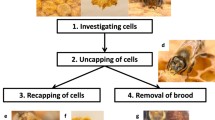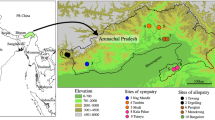Abstract
We investigated the relationship between infestation levels of Nosema ceranae and patriline membership by sampling individual worker bees from five colonies from both Russian and Italian lineages. Individual workers were tested for N. ceranae infestation level using qPCR, and then genotyped to determine their patriline membership. Levels of N. ceranae infestation differed significantly between lineages and colonies for both Russian and Italian workers. Patriline-based variance was evident only among the Russian workers. There was substantial variation in N. ceranae levels among Italian workers, ranging from 0 to 2 × 109 Nosema/bee, but this variation was unrelated to patriline membership. The results for Russian honey bees are congruent with predictions derived from the parasite hypothesis for the evolution of polyandry–patrilinial variance in parasite tolerance contributes to colony level resistance by reducing the probability of catastrophic failure that might occur if a colony was genetically homogeneous.



Similar content being viewed by others
References
Baer, B., Schmid-Hempel, P. (1999) Experimental variation in polyandry affects parasite loads and fitness in a bumble-bee. Nature 397, 151–154
Beye, M., Gattermeier, I., Hasselmann, M., Gempe, T., Schioett, M., Baines, J.F., Schlipalius, D., Mougel, F., Emore, C., Rueppell, O., Sirviö, A., Guzmán-Novoa, E., Hunt, G., Solignac, M., Page Jr., R.E. (2006) Exceptionally high levels of recombination across the honey bee genome. Gen. Res. 16, 1339–1344
Bourgeois, A.L., Rinderer, T.E., Beaman, L.D., Danka, R.G. (2010a) Genetic detection and quantification of Nosema apis and N. ceranae in the honey bee. J. Invertebr. Pathol. 103, 53–58
Bourgeois, A.L., Sheppard, W.S., Sylvester, H.A., Rinderer, T.E. (2010b) Genetic lineage identification of Russian honey bees. J. Econ. Entomol. 103, 917–924
Buchler, R., Berg, S., Le Conte, Y. (2010) Breeding for resistance to Varroa destructor in Europe. Apidologie 41, 393–408
Chen, Y., Evans, J.D., Smith, I.B., Pettis, J.S. (2008) Nosema ceranae is a long-present and wide-spread microsporidian infestation of the European honey bee (Apis mellifera) in the United States. J. Invertebr. Pathol. 97, 186–188
Crane, E. (1978) The Varroa mite. Bee World 59, 164–167
Ebert, D., Hamilton, W.D. (1996) Sex against virulence: The coevolution of parasitic diseases. Trends Ecol. Evol. 11, 79–82
Fries, I. (2010) Nosema ceranae in European honey bees (Apis mellifera). J. Invertebr. Pathol. 103, 73–79
Hamilton, W.D. (1980) Sex versus non-sex versus parasite. Oikos 35, 282–290
Hamilton, W.D. (1987) Kinship, recognition, disease and intelligence: constraints of social evolution. In: Ito, Y., Brown, J.L., Kikkawa, J. (eds.) Animal Societies: Theories and Facts, pp. 81–102. Japan Scientific Society Press, Tokyo
Hamilton, W.D., Axelrod, R., Tanese, R. (1990) Sexual reproduction as an adaptation to resist parasites (a review). Proc. Natl. Acad. Sci. 87, 3566–3573
Higes, M., Garcia-Palencia, P., Martin-Hernandez, R., Meana, A. (2007) Experimental infestation of Apis mellifera honeybees with Nosema ceranae (Microsporidia). J. Invertebr. Pathol. 94, 211–217
Higes, M., Martin-Hernandez, R., Botias, C., Bailón, E.G., González-Porto, A.V., Barrios, L., Del Nozal, M.J., Bernal, J.L., Jiménez, J.J., Palencia, P.G., Meana, A. (2008) How natural infestation by Nosema ceranae causes honeybee colony collapse. Environ. Microbiol. 10, 2659–2669
Hughes, W.H.O., Boomsma, J.J. (2004) Genetic diversity and disease resistance in leaf-cutting ant societies. Evolution 58, 1251–1260
Jaenike, J. (1978) On optimal oviposition behavior in phytophagous insects. Theoret. Pop. Biol. 14, 350–356
Jones, O.R., Wang, J. (2010) COLONY: a program for parentage and sibship inference from multilocus genotype data. Molec. Ecol. Resourc. 10, 551–555
Ladie, R.J. (1992) Parasites and sex: catching the Red Queen. Trends Ecol. Evol. 7, 405–408
Lively, C.M. (1987) Evidence from a New Zealand snail for maintenance of sex by parasitism. Nature 328, 519–521
Lively, C.M., Craddock, C., Vrijenhoek, R.C. (1990) Red queen hypothesis supported by parasitism in sexual and clonal fish. Nature 344, 864–866
Martin-Hernandez, R., Meana, A., Prieto, L., Salvador, A.M., Garrido-Bailon, E., Higes, M. (2007) Outcome of colonization of Apis mellifera by Nosema ceranae. Appl. Environ. Microbiol. 73, 6331–6338
Palmer, K.A., Oldroyd, B.P. (2000) Evolution of multiple mating in the genus Apis. Apidologie 31, 235–248
Palmer, K.A., Oldroyd, B.P. (2003) Evidence for intra-colonial genetic variance in resistance to American foulbrood of honey bees (Apis mellifera): further support for the parasite/pathogen hypothesis for the evolution of polyandry. Naturwissenschaften 90, 265–268
Paxton, R.J., Klee, J., Korpela, S., Fries, I. (2007) Nosema ceranae has infected Apis mellifera in Europe since at least 1998 and may be more virulent than Nosema apis. Apidologie 38, 558–565
Rinderer, T.E., de Guzman, L.I., Delatte, G.T., Stelzer, J.A., Lancaster, V.A., Kuznetsov, V., Beaman, L., Watts, R., Harris, J.W. (2001) Resistance to the parasitic mite Varroa jacobsoni in honey bees from far-eastern Russia. Apidologie 32, 381–394
Schmid-Hempel, P. (1995) Parasites and social insects. Apidologie 26, 255–271
Schuelke, M. (2000) An economic method for the fluorescent labeling of PCR fragments. Nature Biotechnol. 18, 233–234
Seeley, T.D., Tarpy, D.R. (2007) Queen promiscuity lowers disease within honeybee colonies. Proc. Roy. Soc. B: Biol. Sci. 274, 67–72
Sherman, P.W., Seeley, T.D., Reeve, H.K. (1988) Parasites, pathogens and polyandry in social hymenoptera. Am. Nat. 131, 602–610
Shykoff, J.A., Schmid-Hempel, P. (1991a) Genetic relatedness and eusociality: parasite-mediated selection on the genetic composition of groups. Behav. Ecol. Sociobiol. 28, 371–376
Shykoff, J.A., Schmid-Hempel, P. (1991b) Parasites and the advantage of genetic variability within social insect colonies. Proc. Roy. Soc. Lond. B: Biol. Sci. 243, 55–58
Solignac, M., Mougel, F., Vautrin, D., Monnerot, M., Cornuet, J.M. (2007) A third-generation microsatellite-based linkage map of the honey bee, Apis mellifera, and its comparison with the sequence-based physical map. Genome Biol. 8, R66. doi:10.1186/gb-2007-8-4-r66
Tarpy, D.R. (2003) Genetic diversity within honeybee colonies prevents severe infestations and promotes colony growth. Proc. Roy. Soc. Lond. B: Biol. Sci. 270, 99–103
Tarpy, D.R., Seeley, T.D. (2006) Lower disease infestations in honeybee (Apis mellifera) colonies headed by polyandrous vs monandrous queens. Naturwissenschaften 93, 195–199
Tooby, J. (1982) Pathogens, polymorphism, and the evolution of sex. J. Theor. Biol. 97, 557–576
van Baalen, M., Beekman, M. (2006) The costs and benefits of genetic heterogeneity in resistance against parasites in social insects. Am. Nat. 167, 568–577
van Valen, L. (1973) A new evolutionary law. Evol Theory 1, 1–30
Wang, J. (2004) Sibship reconstruction from genetic data with typing errors. Genetics 166, 1963–1979
Wang, J., Santure, A.W. (2009) Parentage and sibship inference from multilocus genotype data under polygamy. Genetics 181, 1579–1594
Acknowledgments
We thank Lorraine Beaman, Tony Stelzer, Stephanie Johnson, Andrew Ellender, and Julian Escobar for their contributions to sample processing. We also thank Joshua Wales and Jeremy Wagnitz for sample collection. Mention of a trade name, proprietary product, or specific equipment does not constitute a guarantee or warranty by the USA Department of Agriculture and does not imply approval to the exclusion of other products that may be suitable.
Author information
Authors and Affiliations
Corresponding author
Additional information
Manuscript editor: Peter Rosenkranz
Les profils de l’infestation d’ Apis mellifera par Nosema ceranae soutiennent l’hypothèse de la relation hôte-parasite expliquant l’évolution d’une très forte polyandrie chez les insectes eusociaux.
Polyandrie / lignée paternelle / Nosema ceranae / Apis mellifera / évolution de la polyandrie
Das quantitative Muster der Infektionen mit Nosema ceranae bei Apis mellifera unterstützt die Parasitenhypothese bezüglich der Evolution einer extremen Polyandrie bei eusozialen Insekten.
Polyandrie / Patrilinien / Nosema ceranae / Apis mellifera / Evolution von Polyandrie
Rights and permissions
About this article
Cite this article
Bourgeois, A.L., Rinderer, T.E., Sylvester, H.A. et al. Patterns of Apis mellifera infestation by Nosema ceranae support the parasite hypothesis for the evolution of extreme polyandry in eusocial insects. Apidologie 43, 539–548 (2012). https://doi.org/10.1007/s13592-012-0121-5
Received:
Revised:
Accepted:
Published:
Issue Date:
DOI: https://doi.org/10.1007/s13592-012-0121-5




